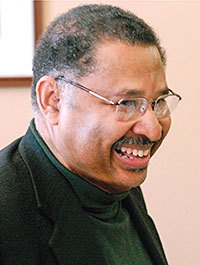Homer Alfred Neal Jr
DOI: 10.1063/PT.3.4076
Homer Alfred Neal Jr, prominent high-energy physicist, university administrator, science education policy leader, and 2016 American Physical Society president, died on 23 May 2018 in Ann Arbor, Michigan, of complications following a stroke. At the time of his death, he was the Samuel A. Goudsmit Distinguished University Professor of Physics at the University of Michigan.

Homer Alfred Neal Jr
JENS ZORN

Born on 13 June 1942, Homer grew up in the small, segregated Kentucky town of Franklin. His interest in ham radio, which connected him to the world, bolstered his interest in science. A prodigy, he left for college at Indiana University (IU) at age 15. He graduated in 1961 with a degree in physics and went on to graduate school at the University of Michigan. His 1966 dissertation on the polarization parameter in elastic proton–proton scattering was completed under the supervision of Mike Longo. Polarization and spin remained a passionate physics focus throughout Homer’s career.
After completing his PhD, Homer spent a year at CERN as an NSF fellow. He then returned to IU as an assistant professor and continued his polarization research at the Argonne Zero-Gradient Synchrotron, Fermilab, and SLAC. He founded the IU high-energy-physics group and was the co-principal investigator of its first Department of Energy contract, awarded in 1969. In 1972 Homer became a full professor. From 1976 to 1981, as IU’s dean of research and graduate development, he established several innovative programs, including a minority fellowship program; brought in record levels of sponsored research support; founded the IU Art Museum; and began the journal Research and Creative Activity.
In 1981 Homer moved to the State University of New York at Stony Brook, where he was a professor of physics until 1987 and served as provost and vice president for academic affairs until 1986. That year he was presented with the Stony Brook Medal.
Homer joined the National Science Board (NSB) in 1980. The following year he chaired the committee that wrote the 15th NSB report on science indicators, and he led the Committee on Undergraduate Science and Engineering Education and an advisory board on human resources. He worked to develop policies on undergraduate science education, an area that had been relatively neglected, and he laid the foundation for government-funded programs to support undergraduate studies, including the NSF Research Experience for Undergraduates (REU).
While serving on the NSB, one of us (Duderstadt), then provost of the University of Michigan, met Homer and successfully recruited him to chair the physics department in 1987. Homer led a renaissance for Michigan physics that included building strong programs and alliances across campus and launching a major expansion of physics facilities. He initiated and coordinated the CERN REU summer program and developed a seminar in science policy that led to his coauthoring the widely used 2008 textbook Beyond Sputnik: U.S. Science Policy in the Twenty-First Century. When the university needed a new vice president for research, Homer was recruited and again undertook new initiatives, such as a university-wide advisory board on scientific research and education. From 1996 to 1997, he served as Michigan’s interim president.
Throughout his years as a university administrator, Homer remained engaged in forefront high-energy-physics research. The technical expertise reflected in his 1000-plus papers included particle-detector design, development of image pattern-recognition algorithms, reconstruction and analysis of particle events, large-scale database management, and particle-physics phenomenology. His analysis of proton–proton polarization and scattering cross sections provided initial evidence for the existence of proton substructure.
As members of the Fermilab DZero collaboration, Homer and his research group designed, implemented, and analyzed data from the intercryostat detector. Their work helped in the discovery of the Ξb hyperon and the lifetime measurement of the Λb.
In 1997 Homer formed a new group at Michigan to participate in the ATLAS experiment at CERN’s Large Hadron Collider. The group ultimately became one of the collider’s largest university groups based in the US. Under his leadership, a large component of the ATLAS muon spectrometer was built at Michigan.
Homer served on advisory boards for universities, national laboratories, and corporations; as chairman of the NSF Physics Advisory Committee; as a Smithsonian Institution regent; and on the Council for the Smithsonian National Museum of African American History and Culture. He often testified before Congress on matters ranging from the funding of national labs to the state of undergraduate science education. His 1998 testimony before the House Science Committee led to the report Unlocking Our Future: Toward a New National Science Policy. In 2003 he received the American Physical Society’s Edward A. Bouchet Award for his contributions to experimental high-energy physics and his service and advocacy for diversity and educational opportunity.
With his dedication to research and service came opportunities for Homer and his family to travel. His favorite places included Geneva, Copenhagen, and Aspen, Colorado. He loved woodworking, photography, fishing, canoeing, cross-country skiing, and boating. But most notable was Homer’s joy in working with CERN REU students and with his grad students, postdocs, and colleagues. That joy was returned by the many of us fortunate enough to have known and worked with him.
More about the Authors
Timothy Chupp. University of Michigan, Ann Arbor.
James Duderstadt. University of Michigan, Ann Arbor.
Harold Ogren. Indiana University Bloomington.
